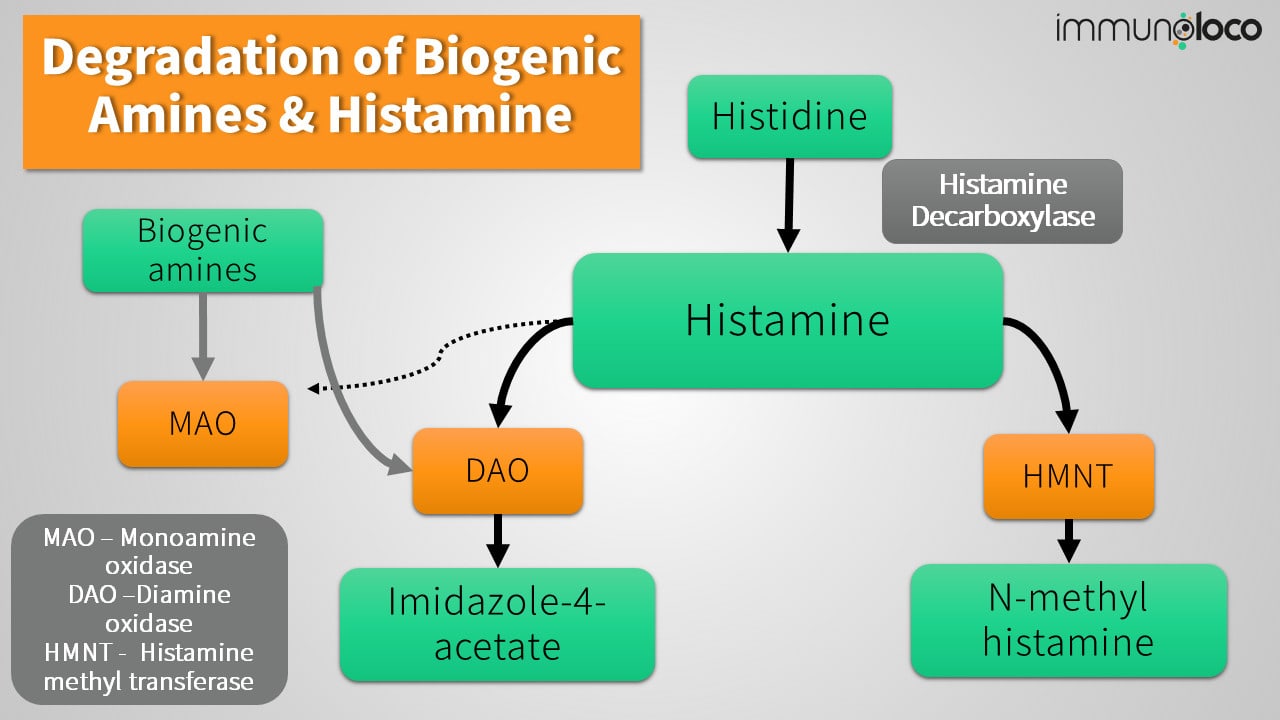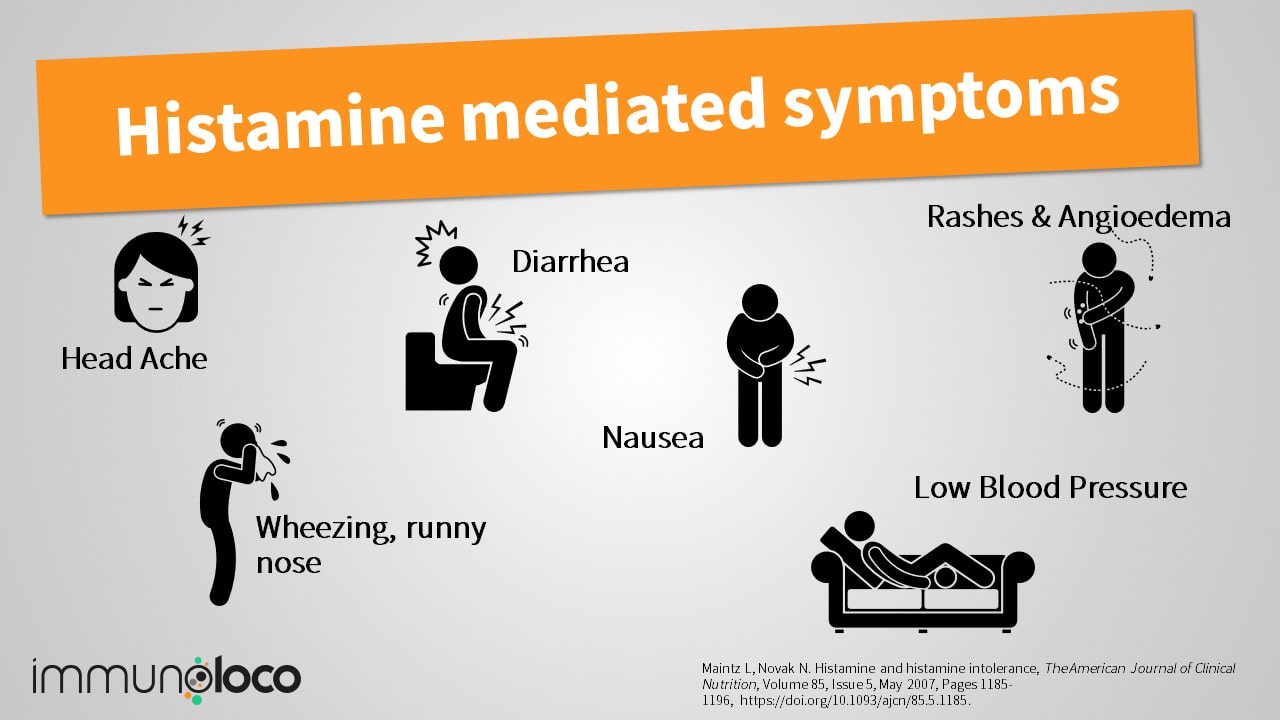
Amino acids are building blocks of body proteins and therefore essential for life. Certain amino acids cannot be produced by the body itself; consequently, they must be ingested through food. It is therefore important to have a balanced supply of protein in the diet, which is sometimes more challenging in cases of histamine intolerance and/or food allergies and mast cell diseases.
Amino acids that may be useful in histamine intolerance syndrome (HIS) and mast cell activation syndrome (MCAS) include:
- Creatine
- Glycine
- Methionine (e.g., when abstaining from all animal and certain vegan protein sources.)
Histidine should be avoided in cases of histamine intolerance, as histamine is formed from it in the body by means of histidine decarboxylase.
This article is about a health issue. It is important that you have your symptoms examined and treated by medical professionals. This article is not intended to be, and cannot be, a substitute for the care and advice of medical professionals that may be available to you.
Creatine in Histamine Intolerance and Mast Cell Activation Syndrome (MCAS)
Creatine is one of the most researched dietary supplements. Studies exist on its use from osteoporosis to neurodegenerative diseases.
These show that creatine may be helpful in a variety of metabolic processes. The following effects of creatine have already been demonstrated in scientific studies1–4:
- Reduction of cholesterol and triglycerides
- Reduced fat accumulation in the liver
- Reduction of homocysteine levels
- Improved blood sugar control
- Increase in strength and/or muscle mass
- Better cognitive function
- Improved bone density (when accompanied by exercise)
- Partially formation of an antidepressant effect as well as reduction of fatigue
In addition to the “typical” areas of application in sports, injury management, and rehabilitation after training, creatine has positive effects that can benefit people with histamine intolerance and mast cell diseases. Especially since creatine-rich foods such as salmon, beef, etc. are often only poorly tolerated in these conditions.
Creatine could possibly help sufferers who complain of poor performance due to “brain fog”. In addition, sufferers often have problems maintaining their weight or building up muscles. Both aspects are crucial to counteract subsequent problems ranging from underweight to osteoporosis.

Creatine Side Effects
It all sounds almost a little too good to be true – doesn’t it? The effects in the studies are not necessarily all that great and often more subtle.
Nevertheless, creatine is one of the safest supplements available. It has been used in doses ranging from 0.3 to 0.8 g/kg of body weight per day in a wide variety of subject groups (elderly, children, and even pregnant women) with no harmful side effects.1
One side effect described is weight gain. On the positive side, creatine ingestion does not appear to suppress the body’s amino acid production. Even high doses up to 30 grams per day were not associated with an accumulation of kidney disease..1
Creatine in the Diet and Dose Recommendations?
Prof. Dr. Theo Wallimann5 recommended as early as 1984 to aim for 3 grams of creatine per day for general health. Now the question arises: Can’t I reach this amount with my diet?
The answer is: probably not – one to two grams of creatine are contained in one pound (!) of raw beef. Vegetarians generally tend to have lower levels.
Supplementation: An Easy Way to Increase Creatine Levels?
There are different approaches to taking creatine: for example, the so-called “loading phase”, in which a higher amount of creatine is taken over five to seven days to replenish the stores. After that, the dose is reduced to a maintenance dose.
Another option is a constant supplementation of, for example, 3 grams a day. In addition, care should be taken to ensure that the creatine is taken with carbohydrates because it is better absorbed that way.1

Glycine: Remedy for Insomnia Caused by Histamine?
Glycine is a non-essential amino acid, which means that humans can produce it. It is synthesized from choline, threonine, and serine. In the production of glycine from choline, methyl groups are generated. It is also a precursor of creatine.
Glycine protects gastrointestinal cells in various cell and animal models and has an anti-inflammatory activity, so it would be of great interest to study this in humans. Likewise, the amino acid hindered the development of gastric ulcers in animal models.6
It also has a hepatoprotective effect, meaning that it appears to have a positive impact on liver health.6
Another benefit of glycine is that this amino acid improves subjective sleep quality and may help with sleep disorders.7 Histamine is an excitatory neurotransmitter that has a stimulating effect on the central nervous system. Patients with histamine intolerance syndrome (HIS) or mast cell activation syndrome (MCAS) often describe sleep and wake rhythms disturbances.
Furthermore, glycine causes body temperature to drop at night. Researchers believe this drop may also improve sleep.8 In addition, REM sleep was prolonged in one study.9
Side Effects. Glycine is Considered Harmless Even in High doses
Glycine is considered very safe even in high doses, both in humans and animals. In rats, high doses over four weeks of 2g/kg were not toxic.10 In some cases, doses of up to 30 (!) grams per day were used in human studies. In one case, nausea with vomiting occurred, which caused the discontinuation of treatment in this individual..11(p)
MAP Amino Acids for Histamine Intolerance
MAP stands for Master Amino Acid Pattern. According to Prof. Dr. Lucà-Moretti, it represents the optimal ratio of the eight essential amino acids for humans so that as little nitrogen waste and ammonia as possible is produced. MAP® supplements are used to correct protein deficiencies. Supplementation with MAP® is comparatively expensive.
To ensure adequate protein intake in cases of histamine intolerance, one should watch their protein supply to provide a balanced amino acid profile, so no further supplements like MAP® are needed. For example, one can mix pea and rice protein in a 30% to 70% ratio for an optimized amino acid profile.
Rice protein does not contain enough lysine but more methionine. It, therefore, makes sense to alternate and rotate protein sources to ensure optimal supply.
In the case of severe kidney or liver disease, it may be advisable to reduce the nitrogen and ammonia drop through protein intake – but this must decide the attending medical professional.
Methionine or S-Adenosyl-Methionine in Histamine Intolerance, Allergies or MCAS
Methionine is a sulfur-containing amino acid found primarily in animal protein sources such as salmon, chicken, and non-animal proteins like soybeans, chickpeas, and millet. As a rule, people consume enough of this amino acid in their diet.
S-adenosyl-methionine, or S-adenosyl-L-methionine (SAMe), is the active form of methionine, but it is relatively unstable in some supplement forms. SAMe is a methyl group donor in the body and plays an essential role in methylation processes in the human body.
One of the degradation pathways of histamine is via histamine methyl transferase (HNMT for short) and is also based on a methylation reaction, which is why there is repeated speculation as to whether taking methionine could help allergy sufferers.12 However, studies in humans are still lacking.

Since a sufficient amount of methionine, especially S-adenosyl-methionine, is associated with reduced oxidative stress in animal models of asthma, one should make sure to ingest enough methionine in the diet.13.13
In addition, methionine is used in Germany to prevent recurrent urinary tract infections by providing this amino acid to acidify the urine.
n a retrospective study with patients after kidney transplantation, methionine was able to provide an almost half reduction in the occurrence of urinary tract infections, but the effect was somewhat weaker compared to the intake of cranberry juice.14
Side Effects: Increase Homocysteine Levels and Gastrointestinal Complaints
Excessive intake of methionine can increase homocysteine levels, which is considered a risk marker for atherosclerosis, among other things.15 This is particularly the case when there is no adequate intake of folic acid, vitamin B6, and B12.
Gastrointestinal complaints may also occur.16 Therefore, it is best to see if one can meet one’s needs through diet or work specifically with therapists to address this.
Excursion: Methylation is not yet fully understood: It influences epigenetic processes to a high degree. Epigenetics is responsible for controlling whether specific genes are “switched on or off”. Therefore, I would be very cautious about taking high doses of methionine or SAMe, for example, or likewise methylated folic acid (methyl folate or 5-MTHF) without proven deficiencies or therapeutic guidance.
For example, animal studies showed that very high doses of methyl folate were associated with more atopic disease in the offspring. In humans, these study results were inconclusive – some showed this effect and others did not17
References
1. Kreider RB, Kalman DS, Antonio J, et al. International Society of Sports Nutrition position stand: safety and efficacy of creatine supplementation in exercise, sport, and medicine. Journal of the International Society of Sports Nutrition. 2017;14(1):18. doi:10.1186/s12970-017-0173-z
2. Stead LM, Au KP, Jacobs RL, Brosnan ME, Brosnan JT. Methylation demand and homocysteine metabolism: effects of dietary provision of creatine and guanidinoacetate. Am J Physiol Endocrinol Metab. 2001;281(5):E1095-1100. doi:10.1152/ajpendo.2001.281.5.E1095
3. Santos RVT, Bassit RA, Caperuto EC, Costa Rosa LFBP. The effect of creatine supplementation upon inflammatory and muscle soreness markers after a 30km race. Life Sci. 2004;75(16):1917-1924. doi:10.1016/j.lfs.2003.11.036
4. Op ’t Eijnde B, Ursø B, Richter EA, Greenhaff PL, Hespel P. Effect of oral creatine supplementation on human muscle GLUT4 protein content after immobilization. Diabetes. 2001;50(1):18-23.
5. ETH Zürich – Theo Wallimann. Accessed July 29, 2021. https://www.bi.id.ethz.ch/personensuche/personenDetail.view?lang=de&pid=1312E
6. Razak MA, Begum PS, Viswanath B, Rajagopal S. Multifarious Beneficial Effect of Nonessential Amino Acid, Glycine: A Review. Oxid Med Cell Longev. 2017;2017:1716701. doi:10.1155/2017/1716701
7. Yamadera W, Inagawa K, Chiba S, Bannai M, Takahashi M, Nakayama K. Glycine ingestion improves subjective sleep quality in human volunteers, correlating with polysomnographic changes. Sleep Biol Rhythms. 2007;5(2):126-131. doi:10.1111/j.1479-8425.2007.00262.x
8. Bannai M, Kawai N. New therapeutic strategy for amino acid medicine: glycine improves the quality of sleep. J Pharmacol Sci. 2012;118(2):145-148. doi:10.1254/jphs.11r04fm
9. Kawai N, Sakai N, Okuro M, et al. The sleep-promoting and hypothermic effects of glycine are mediated by NMDA receptors in the suprachiasmatic nucleus. Neuropsychopharmacology. 2015;40(6):1405-1416. doi:10.1038/npp.2014.326
10. Shibui Y, Miwa T, Yamashita M, Chin K, Kodama T. A 4-week Repeated Dose Toxicity Study of Glycine in Rats by Gavage Administration. J Toxicol Pathol. 2013;26(4):405-412. doi:10.1293/tox.2013-0026
11. Heresco-Levy U, Javitt DC, Ermilov M, Mordel C, Silipo G, Lichtenstein M. Efficacy of High-Dose Glycine in the Treatment of Enduring Negative Symptoms of Schizophrenia. Arch Gen Psychiatry. 1999;56(1):29. doi:10.1001/archpsyc.56.1.29
12. Pacheco Y, Macovschi O, Biot N, Fonlupt P, Perrin-Fayolle M, Pacheco H. Modulation by S-adenosyl-methionine and S-adenosyl-homocysteine of the human leucocytes histamine release. Clin Allergy. 1984;14(1):37-43. doi:10.1111/j.1365-2222.1984.tb02187.x
13. Yoon S-Y, Hong GH, Kwon H-S, et al. S-adenosylmethionine reduces airway inflammation and fibrosis in a murine model of chronic severe asthma via suppression of oxidative stress. Exp Mol Med. 2016;48(6):e236. doi:10.1038/emm.2016.35
14. Pagonas N, Hörstrup J, Schmidt D, et al. Prophylaxis of recurrent urinary tract infection after renal transplantation by cranberry juice and L-methionine. Transplant Proc. 2012;44(10):3017-3021. doi:10.1016/j.transproceed.2012.06.071
15. Ditscheid B, Fünfstück R, Busch M, Schubert R, Gerth J, Jahreis G. Effect of L-methionine supplementation on plasma homocysteine and other free amino acids: a placebo-controlled double-blind cross-over study. European Journal of Clinical Nutrition. 2005;59(6):768-775. doi:10.1038/sj.ejcn.1602138
16. PharmaWiki – Methionin. Accessed July 29, 2021. https://www.pharmawiki.ch/wiki/index.php?wiki=Methionin
17. Sharma S, Litonjua A. Asthma, Allergy, and Responses to Methyl Donor Supplements and Nutrients. J Allergy Clin Immunol. 2014;133(5):1246-1254. doi:10.1016/j.jaci.2013.10.039
https://www.medica-kiel.de/gesundheitsbibliothek/index/l-methionin/
https://www.medica.de/de/News/Archiv/Die_Entdeckung_des_Master_Amino_Acid_Pattern_(MAP)_–_spezifisches_Aminosäurenmuster_des_Menschen
Immunoloco unterstützen
immunoloco möchte Betroffenen kostenlos gute und hilfreiche Informationen rund um ein verrücktes Immunsystem bieten. Du findest das gut? Dann unterstütze immunoloco und meine Arbeit doch gerne. Jeder Euro zählt und hilft, das Projekt weiterleben zu lassen.

Love this article is help my family so much
Thank you for the feedback!
I noticed at the onset of hives when I take creatine and methionine they are greatly reduced or disappear.
Thanks Mary for sharing your experience!
Best wishes
Lisa